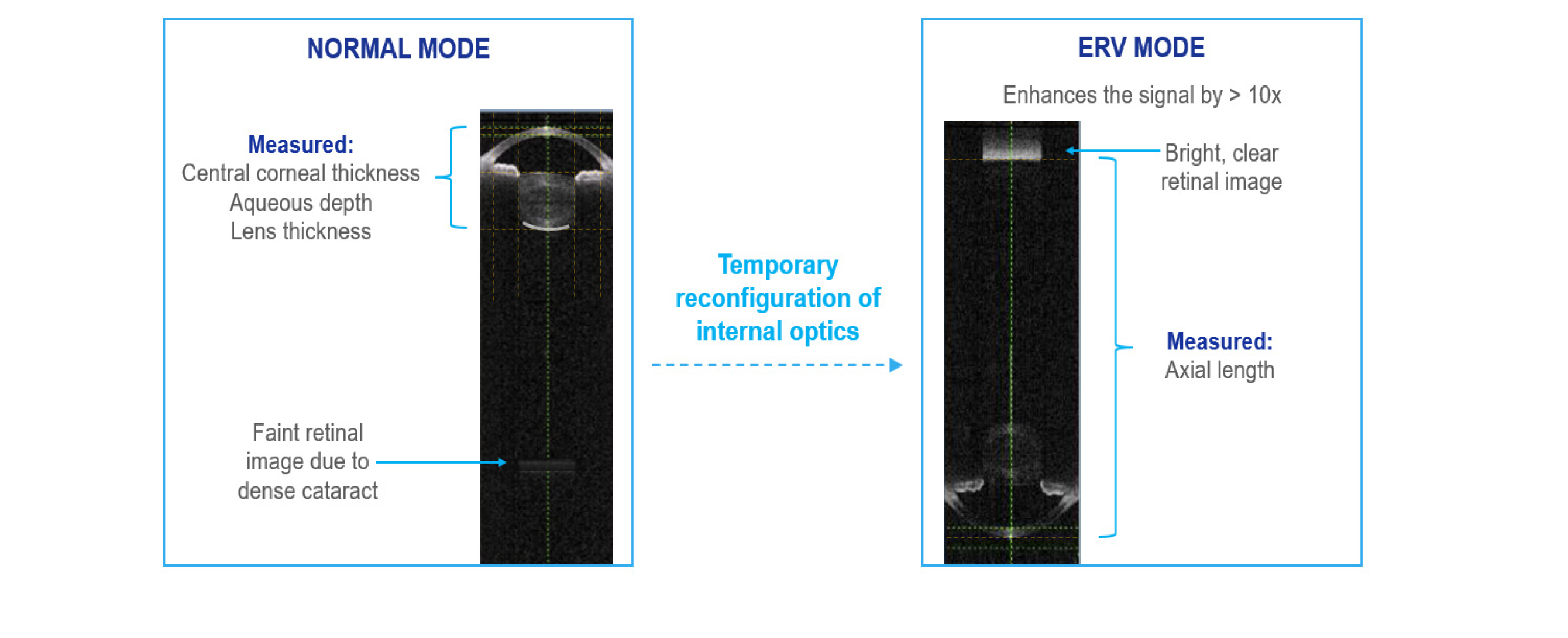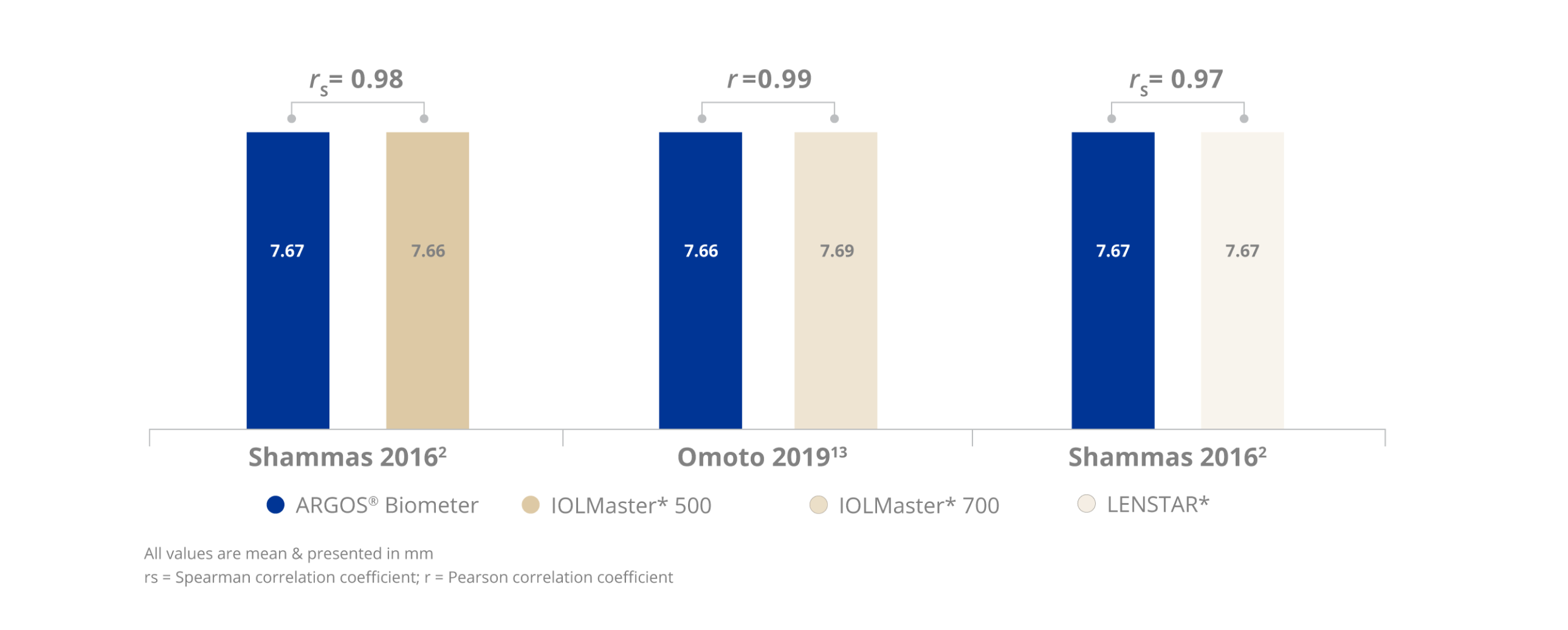The ARGOS® Biometer with Image Guidance by Alcon®
FASTER.1-5* EASIER.5,6† BETTER.1,2,7,8‡
The ARGOS® Biometer with Image Guidance by Alcon®
FASTER.1-5* EASIER.5,6† BETTER.1,2,7,8‡
*Compared to IOLMaster§ 700 (1,4), IOLMaster§ 500 (2,3), LENSTAR§ LS900 (2). †Compared to VERION™ Reference Unit.
‡ARGOS® Biometer has shown better acquisition rates in dense cataract compared to IOLMaster§ 700 (1), IOLMaster§ 500 and LENSTAR§ LS900 (2). ARGOS® Biometer has shown better predictive accuracy in medium-long eyes than IOLMaster§ 500 (7,8). § Trademarks are the property of their respective owners.

Your Surgery Journey Begins at the Clinic
Get ready to discover the ARGOS® Biometer – the smart planning solution.

Advanced Biometry1,2,7,8
The swept-source OCT ARGOS® Biometer with Image Guidance by Alcon® is an innovative solution, designed to enhance your surgical experience and help to achieve better patient outcomes.1,2,7,8
The ARGOS® Biometer is faster than other market-leading biometers.1-5† With a biometric data capture time of less than 1 second and a higher scanning speed, 50% faster than IOLMaster* 700, the ARGOS® Biometer allows for enhanced efficiency and accuracy of eye measurements.1,9
Auto-capture mode automatically records measurements when the patient is optimally aligned, without requiring any extra steps.
The ARGOS® Biometer captures biometric data of5,10:
- Anterior Chamber Depth (ACD)
- Keratometry (K)
- Corneal Diameter / WTW
- Central Corneal Thickness (CCT)
- Axial Length (AL)
- Aqueous Depth (AD)
- Pupil Size (PD)
- Lens Thickness (LT)
- Angle Kappa Coordinates (Px and Py)
*Trademarks are the property of their respective owners. †Compared to IOLMaster* 700 (1,4), IOLMaster* 500 (2,3), LENSTAR* LS900 (2).
The ARGOS® Biometer Provides Higher Acquisition Rates Than Other Market-Leading Biometers1,2,7,8
With SS-OCT Technology and proprietary Enhanced Retina Visualization mode, the ARGOS® Biometer provides unsurpassed dense cataract penetration and accuracy of axial length acquisition.1,2,7,8
It allows for confidence in refractive outcomes even in the case of grade 4+ cataract patients.12
Enhanced Retina Visualization mode illustration

The ARGOS® Biometer shows significantly higher acquisition rates in grade 4+ cataracts compared to the IOLMaster* 700 and other market-leading biometers, while significantly reducing the need for time-consuming ultrasound biometry.1,2

*Trademarks are the property of their respective owners.
In medium and high density eyes (Groups B and C), mean absolute error (MAE) was significantly lower with the ARGOS® Biometer12
Comparison of the refractive outcomes in patients with dense nuclear cataract between the ARGOS® Biometer and IOLMaster* 70012

*Trademarks are the property of their respective owners.
†Wilcoxon signed rank test.
*Trademarks are the property of their respective owners.


One-Touch Planning with Alcon Vision Planner
Easy One-Touch Planning and IOL Power Calculations with Alcon Vision Planner5,6
The ARGOS® Biometer and integrated Alcon Vision Planner makes the process of surgery planning and IOL power calculation easier.* This comprehensive tool eliminates the need for complicated online and manual calculations while continuing to optimise patient outcomes with Image Guidance by Alcon®.5
*Compared to VERION™ Reference Unit.
Alcon Vision Planner:
- Utilises Image Guidance by Alcon® for astigmatism management and surgery planning5
- Offers advanced IOL power calculation with the ability to easily compare formulas and IOLs on the same page
- Provides built-in optimisation algorithms to support ongoing personalisation of your SIA and A-constants5
The Alcon Vision Planner uses the following formulas5:
- Barrett Toric Calculator
- Barrett Universal II
- Barrett True K
- Barrett True K Toric
- Barrett Total K*
- SRK-T
- Holladay I/II
- Holladay R
- Haigis
- Hoffer-Q
*Barrett Total K formula can be used if posterior keratometry is manually entered into the planning software


Image-Guided Integration

Discover the image-guided precision of astigmatism correction with the ARGOS® Biometer, integrated with the Alcon Cataract Refractive Suite
The ARGOS® Biometer captures a reference image of each patient’s unique eye during measurement. With seamless end-to-end integration between the clinic and the OR, it transfers the reference image to the Digital Markers together with the surgical plan, enabling real-time navigation using the patient's unique iris and limbal landmarks as a guide for precise execution of your surgical plan.5
Image Guidance by Alcon®1-8:
- Reduces risk of transcription errors
- Accurately accounts for cyclotorsion
- Reduces variability from manual marking
- Enhances surgical precision

Integration with the Digital Marker Microscope helps you execute your patient’s surgical plan with digital accuracy15:
- Navigate and track every step of your surgery in real time using your patient’s unique eye landmarks
- Cyclotorsion control
- Step-by-step procedural navigation using CENTURION® foot-pedal control

Enhance your LenSx® Laser experience with seamless image-guided incision planning, execution and capsulorhexis positioning.16*
*Requires VERION™ Digital Marker L (with LenSx®).

Alcon Cataract Refractive Suite
The Alcon Cataract Refractive Suite allows you to experience complete integration for intelligent planning and empowered execution with enhanced precision at every step.
Discover Alcon Services
Supported by World-Class Service Centered on You


Reach
The Largest Network
1000+ Clinical and technical
experts worldwide


Expertise
The Most Experienced Specialists
Alcon Technical Specialists
100+ Hours of training and certification
Alcon Clinical Specialists
15+ Years of ophthalmic and medical experience


Partnership
Training & Collaboration
Every Step of the Way
Installation
Training
Ongoing Support
Clinical Support
Technical Specifications5

Instructions for Use (IFU)
For a full list of indications, contraindications and warnings, please visit ifu.alcon.com and refer to the relevant product’s instructions for use.
Alcon Experience Academy
For relevant training content from industry thought leaders
References:
1. Tamaoki A, Kojima T, Hasegawa A, et al. Clinical evaluation of a new swept-source optical coherence biometer that uses individual refractive indices to measure axial length in cataract patients. Ophthalmic Res. 2019;19:1-13.
2. Shammas HJ, Ortiz S, Shammas MC, et al. Biometry measurements using a new large-coherence-length swept-source optical coherence tomographer. J Cataract Refract Surg. 2016;42:50-61.
3. Hussaindeen JR, Mariam EG, Arunachalam S, et al. Comparison of axial length using a new swept-source optical coherence tomography-based biometer. PLoS ONE. 2018;13(12):e0209356.
4. ZEISS IOLMaster 700 510k Submission 2015.
5. ARGOS® Biometer User Manual. 2019.
6. VERION™ Reference Unit User Manual Part I. 2019.
7. Whang W, Yoo Y, Kang M, et al. Predictive accuracy of partial coherence interferometry and swept-source optical coherence tomography for intraocular lens power calculation. Sci Rep. 2018;8(1):13732.
8. Shammas HJ, Shammas MC, Jivrajka RV, Cooke DL, Potvin R. Effects on IOL power calculation and expected clinical outcomes of axial length measurements based on multiple vs single refractive indices. Clin Ophthalmol. 2020;14:1511-1519.
9. Alcon Data on File 2019, report # SD-18-0001-670-01.
10. MOVU ARGOS® 510(k) Summary 2019.
11. Santec Letter of Declaration. Jan 15, 2021.
12. An Y, Kim H, Joo C-K. Accuracy of predicting refractive outcomes using swept-source optical coherence tomography in nuclear cataracts. J Korean Ophthalmol Soc. 2019;60(11):1043-1049.
13. Omoto MK, Torii H, Masui S, Ayaki M, Tsubota K, Negishi K. Ocular biometry and refractive outcomes using two swept-source optical coherence tomography-based biometers with segmental or equivalent refractive indices. Sci Rep. 2019;9:6557.
14. Akman A, Asena L, Güngör SG. Evaluation and comparison of the new swept source OCT-based IOLMaster 700 with the IOLMaster 500. Br J Ophthalmol. 2016;100:1201-1205.
15. VERION™ Digital Marker M User Manual. 2018.
16. VERION™ Digital Marker L User Manual. 2017.
Please refer to relevant product operator’s manual for complete list of indications, contraindications and warnings



